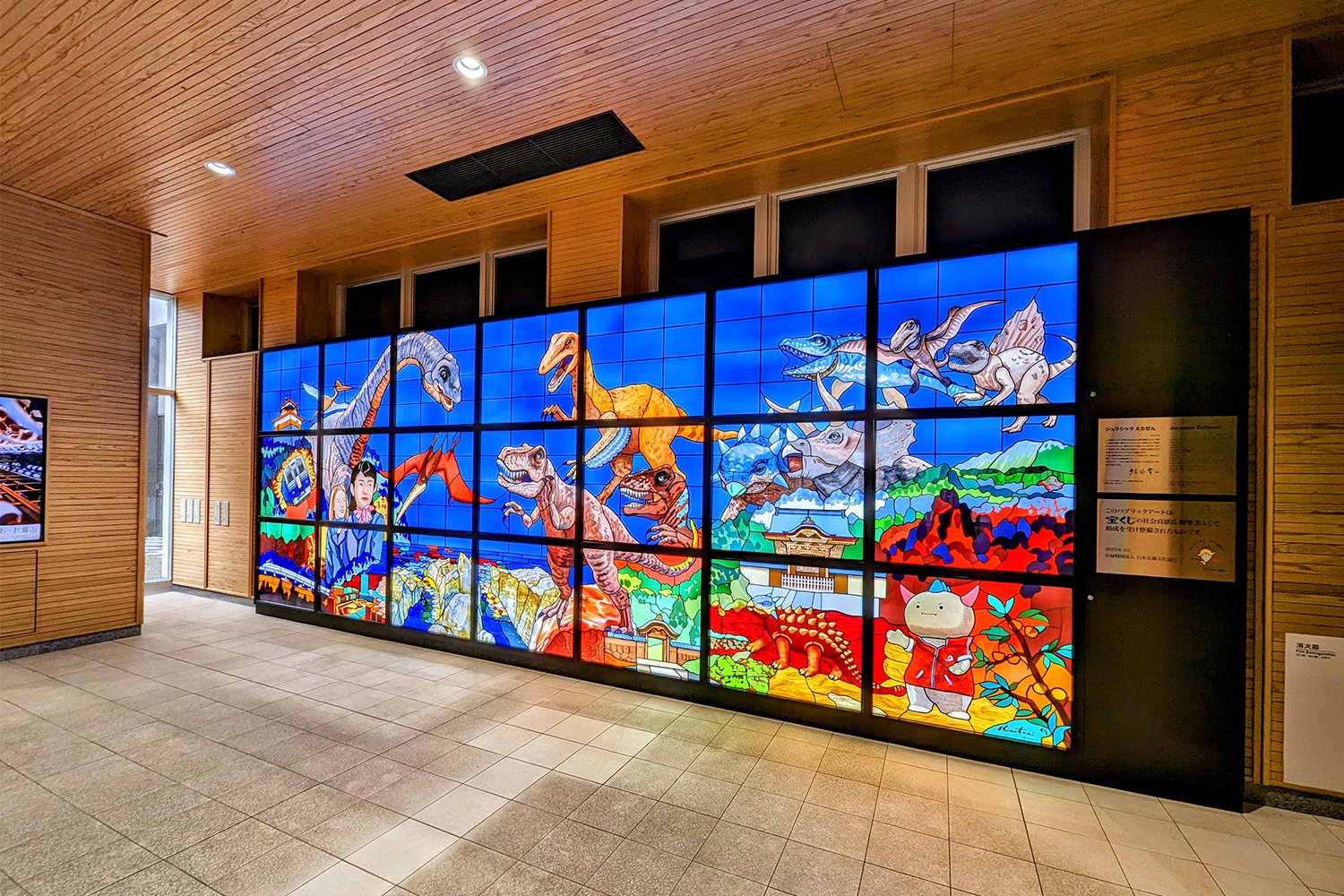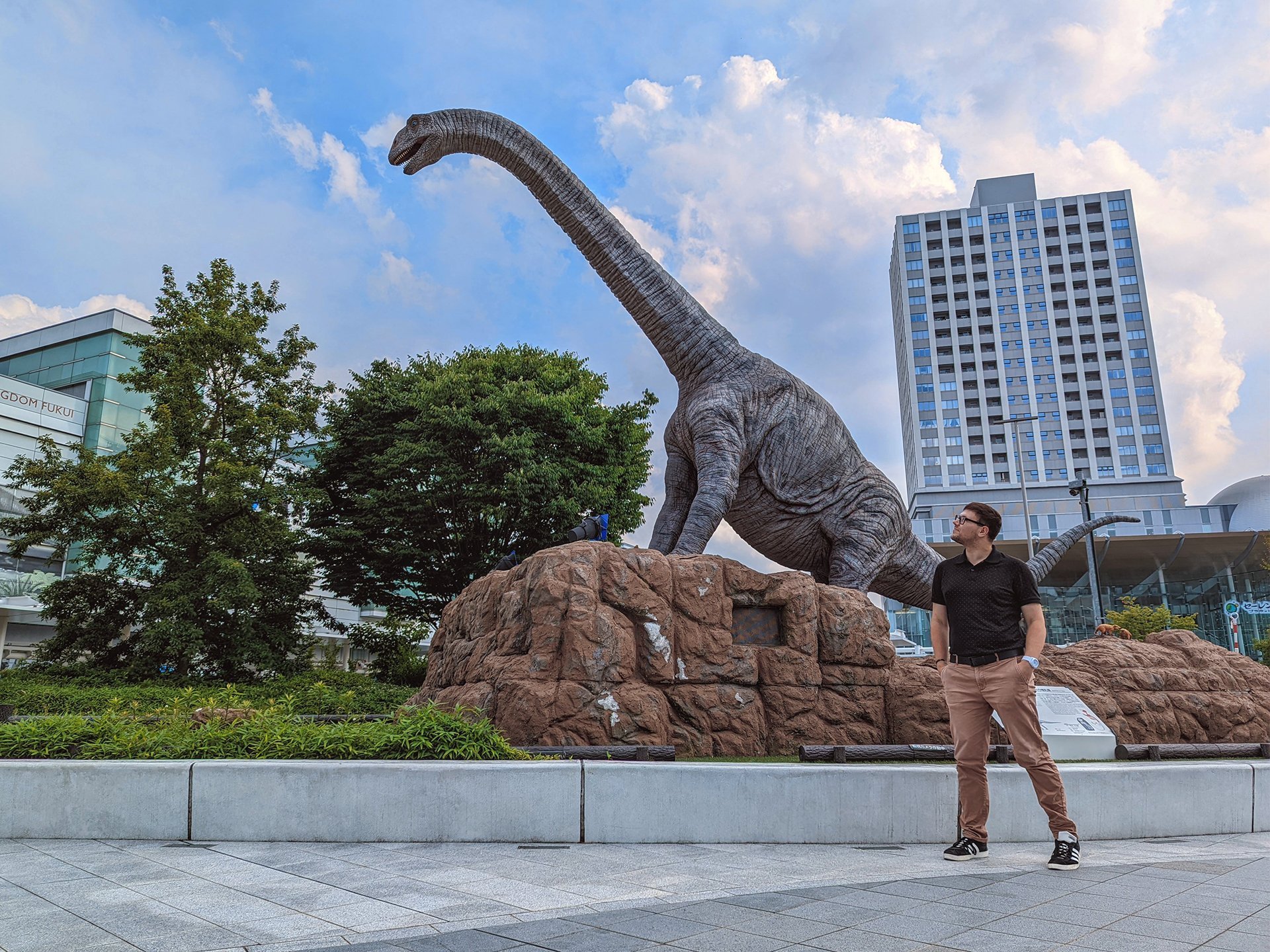Echizen Crafts Tour: Lacquerware and Paper

Fukui’s artisan traditions are among the finest in Japan.
Cover photo: Craftsman Masataka Kinkori (錦古里 正孝) demonstrates the lacquer application process on a wooden bowl at his Kinkori Lacquerware Shop (錦古里漆器店), Kawada, Sabae City, Fukui Prefecture, Japan (2024).
Intro
I joined a local crafts tour this past weekend! I have long wanted to learn more about Fukui’s artisan traditions, especially Echizen urushi (lacquerware) and washi (paper). Both are considered to be among the finest practices in Japan.
Together with other foreign English teachers, I participated in a free trial experience with Craft Invitation by SOE. The group is part of an initiative to promote local industry through sustainable tourism.
We visited many shrines, shops, and studios around the cities of Echizen and Sabae, just south of Fukui City. This area is the epicenter of the prefecture’s historic craft industry. Please read on for more details.
Urushi (Lacquerware)
We traveled by private van from Fukui Station to our first stop, Shikiyama Jinja. It’s said to be one of few shrines dedicated to lacquerware. In the cold winter weather, we climbed some 200 steps to the main hall, where I prayed for a wonderful day.
So what is lacquer? It’s actually tree sap, collected by making deep cuts into the trunks of sumac. The trees release this resin to repair damage; the substance hardens as it is exposed to oxygen, creating a strong layer of protection. Lacquer is resistant to water, acid, bacteria, and corrosion. It’s also good for insulation and thus perfect for dishware.
Besides its practicality, lacquer is also prized for its aesthetic quality as it develops a beautiful glossy luster. The finest products require as many as thirty layers! Lacquer can also serve as an adhesive for gold and silver powders — a technique known as maki-e — or mother-of-pearl inlay, called raden.
Lacquerware — called urushi or shikki — originates in Ancient China. The oldest evidence of Japanese lacquerware was found in Fukui! According to legend, Echizen lacquerware was popularized after artisans here repaired a crown for 6th century Emperor Keitai, over 1,500 years ago. Echizen workers were also involved in the creation of Nikko Toshogu, a 17th century shrine dedicated to the shogun Ieyasu Tokugawa (徳川 家康) north of Tokyo.
About 200 lacquerware studios exist in Sabae today. The humid climate is vital for lacquer to harden properly. Urushi is commercially viable thanks to mechanized processes and synthetic materials. The local industry is governed by the Echizen Lacquerware Cooperative, which ensures fair wages while maintaining high standards of quality. Echizen accounts for over 80% of Japan’s commercial lacquerware — used in restaurants and hotels.
The lacquerware process is highly specialized, relying on a division of labor. Lacquer studios focus only on painting. We visited Shitsurindo — a studio established in 1793 — to learn more. We were given a tour of the facility by Toru Uchida (内田 徹), the studio’s eighth generation head. Shitsurindo artisans create seasonal designs on traditional red and black colors, as well as contemporary collections. Some are even dishwasher safe!
Artisans begin work with prepared wooden bases, often carved from zelkova or cypress. Multiple coats of varying purity are required to prepare and finish the final dish, applied with brushes of human hair! Between layers, these dishes are kept enclosed in spinning cabinets to ensure they dry evenly. Humidity is also closely controlled. It takes over one month for a completed work to dry.
Mr. Uchida says that most commercial lacquerware has a lifespan of about ten years, but urushi can last a lifetime if cared for properly. Currently, only about 10% of his studio’s work involves maintenance and repair because it is more costly than replacement. As more companies embrace sustainability, I hope this number will increase.
Next, we arrived at Kinkori Lacquerware Shop. It was time to try lacquer painting! Masataka Kinkori (錦古里 正孝) — a craftsman of over fifty years — guided us through the experience. We were asked to wear protective gear, as contact with wet lacquer can result in rash! The smell was also strong. It reminded me of petroleum, but also woody and floral.
For optimal access, dishes are attached to handles by wax. Our bowls were already prepared for us with a base coat of red or black. Of course, we only had time to apply one layer of lacquer. Mr. Kinkori showed us how to apply the coat, first brushing up and down, then side to side with generous amounts of lacquer. It was more viscous than I expected, making it difficult to achieve an even finish.
I tried my best, but Mr. Kinkori still had to correct my work. Though the experience was over quickly, it was a nice introduction to the process. Our bowls will be mailed to us in the next few months! I wonder if I will use it for meals or simply display it on my bookshelf.
Kyodo Ryori (Local Cuisine)
Now it was finally time for lunch. I had grown quite hungry from our tour and frankly a bit nauseous from the lacquer fumes, so I was grateful to eat. To my surprise, a luxurious feast was awaiting us at Echizen Lacquerware Hall, prepared by chef Toshie Tanaka (田中 敏江).
We enjoyed our meal on zabuton (cushions) in a traditional tatami (straw mat) room. The ceiling features beautiful lacquerware tiles decorated with elaborate designs of maki-e and raden.
The food was exquisitely presented on lacquerware, in appetizing red. It was a meal of kyodo ryori, or “local cuisine,” including rice, miso soup, okara (pureed soybeans), tempura shrimp, tofu, carrot, mushroom, taro, lotus, and scallops. Some of the dishes take multiple days to prepare!
We also drank hot ocha, green tea. For dessert, we enjoyed fresh strawberries and candied kumquat. It was all so fresh and delicious, made truly sublime in this gorgeous space. Gochisousama deshita, Tanaka-san. Thank you for this wonderful meal.
Washi (Paper)
With our stomachs full, we embarked for Okamoto-Otaki Jinja, said to be Japan’s only site enshrining Kawakami Gozen, the goddess of paper. The main hall resembles the head of a dragon! It looked especially beautiful in the sudden snowfall.
Legend says that it was Kawakami Gozen — “Upriver Princess” — who taught locals the process of papermaking. In actuality, papermaking originated in Ancient China, introduced to Japan by Korean monks around the 7th century. Washi, “Japanese paper,” was first used for writing Buddhist sutras, then origami, fans, shoji (sliding doors), umbrellas, and hariko (papier-mâché).
Only about 50 mills remain in Echizen today, most of which are associated with the Echizen Washi Industrial Cooperative. We visited Iwano Heizaburo Paper Mill, the largest factory in the area that makes paper by hand!
Akiko Tamamura (玉村 秋子) showed us around the facility. She has over sixty years of experience. In fact, papermaking is a field dominated by women — I was surprised. Though in her late 70s, Aki-san was full of life, happily running about the mill while explaining the laborious papermaking process.
Echizen washi is made from a collection of bushes and shrubs, specifically kozo (mulberry), mitsumata (paperbush), gampi, and sometimes hemp. In cold weather they develop strong fibers. They are soaked, boiled, and beaten into a fine pulp which is strained and pressed to make the final sheets. The proportions of plants used affect color and texture.
The most difficult task is removing impurities — such as bark and dirt — from the wet mixture by hand, but the resulting paper is magnificent: thick, lustrous, and soft to the touch. Washi is resistant to water and insects, as well as tearing and yellowing.
Japan’s first paper money was printed on Echizen washi in 1661. Imported to Europe by the Dutch East India Company (VOC), the paper was used by painter Rembrandt for prints and drawings. It’s still popular among artists today. Other applications include certificates, diplomas, and stationery.
We used Echizen washi for calligraphy, taught by artist Kason Nishiyama (西山佳邨). She has designed logos for many local businesses!
Kason-san prepared everyone’s given (first) name in kanji, Japanese characters of Chinese origin. Their pronunciation changes with context. Together, the kanji for “great” (大), “virtue” (仁), and “choice” (選) can be read as Dai-ni-eru (Daniel), which suggests I am a man of virtuous decision-making. I hope I can live up to my name!
The lesson was short. Crucially, Kason-san told us to remember that calligraphy moves from the top left to the bottom right — like Western writing. Also, it’s important to keep the brush perpendicular to your paper. I found this challenging. While I wasn’t completely satisfied with my work, I was impressed with the paper. It made the black ink especially vibrant.
Before we left, Aki-san sang for us “Echizen Kamisuki Uta” (越前紙漉き唄), an old folk song passed down through generations of papermakers since the Edo Period. It was a special moment. I felt its history through her lovely voice!
Final Thoughts
My prayers to the gods came true, because I did have a wonderful day. It was a pleasure learning about lacquerware and paper, but I was especially happy to meet the passionate artisans who keep these traditions alive. In the age of AI (artificial intelligence) art, I find myself increasingly drawn to handmade practices. I hope more people will recognize the value of such skills, and that they will be preserved into the future.
Thanks
Again, I want to thank all the talented artisans I met throughout the day, as well as tour guides Eri Hamamoto (中島 絵理) and Sawyer Scherbenske who made the trip possible.
Author’s Note
I attended this trial tour for free. Also, as part of the Fukui Reporter program, I am tasked with participating in local events and publicly promoting the prefecture. This is a volunteer position that allows me free entrance to a selection of museums throughout the area. The opinions I share are my own.






